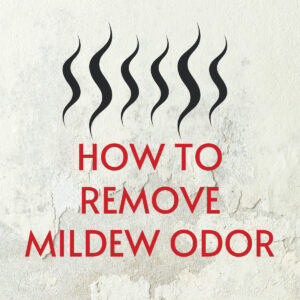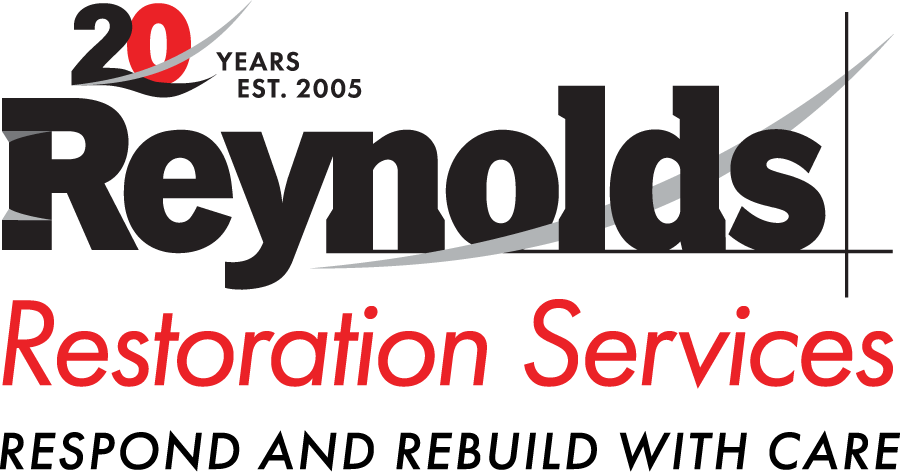
Mildew has a strong, pungent odor and can be indicative of a larger problem – mold growth. Before tackling the mildew smell in your home, it’s important to understand the difference between mold and mildew, how to remove mildew smell, and then how you can prevent it from reoccurring in the future.
Mold vs. Mildew
Many people use the terms mold and mildew interchangeably, and while they share some district characteristics, they are different. Mildew is actually a particular type of mold. Both mold and mildew are fungi, a live organism that grows in damp areas that have been affected by water damage.
Mold and mildew are different in appearance. Mold is typically slimy or fuzzy looking, raised, and can be green, red, blue, or black. Black mold can cause health issues and should be addressed immediately. Mildew, on the other hand, is more powdery in appearance, is flat, and is white in color. Mildew is a type of surface fungus and is usually easier to visually detect. While the fungi is not toxic itself, it can cause respiratory issues with prolonged exposure.
Another way to tell the difference between mold and mildew is the odor. Mildew has a milder, musty smell than mold – the odor is usually compared to wet or damp socks. Mold odor is more pungent and stronger.
Steps to Remove Mildew Smell
If you have a lingering mildew odor in your home or business there is good news – you likely have what you need to remove the odor in your cleaning supplies or your pantry. With some elbow grease and a few cleaning products, you can have your home or business smelling fresh again in no time.
Here are several steps to get rid of musty smells:
- Find the source: Before attempting to clean and deodorize your affected area, the first thing to do is figure out where the musty odor came from in the first place. If you don’t immediately see where the mildew is growing, remove as many items as possible from the room and inspect corners, grout, carpeting, furniture, and other areas to find the source. Mildew is caused by a water issue so look in areas that may have been flooded or there was a water leak.
- Scrub area with diluted bleach: After you’ve located the mildew, you should clean the area with diluted bleach. Mix one part bleach with four parts water, and use a toothbrush or a scrub brush to clean the affected area. Once you’ve cleaned the area with the bleach solution, wipe the area down with a clean sponge. Bleach is a very harsh chemical, so be sure to wear the proper protective equipment such as a mask, gloves, and goggles. Repeat this step to remove stubborn mildew.
- Dry out affected area: Since mildew thrives in damp environments, be sure to completely dry out the affected room or rooms. If possible, open windows to create airflow.
If the musty odor in your home or office is due to mold rather than mildew, there are other cleaning methods to address the mold problem. Common home remedies to remove mold include vinegar and baking soda, borax, and hydrogen peroxide. Never mix chemicals when removing mold or mildew and always use the proper protective equipment.
If you’ve discovered a large mildew or mold issue in your home, consider having a professional mold remediation and odor mitigation company address the issue. If left untreated, or simply covered up, mold spores can quickly spread to other areas of a building and cause long-term issues such as structural damage to the building and health issues for the occupants.
How to Prevent Mildew
Once you eliminate mildew smell and odor from your property, how can you prevent it from returning? The best way to prevent the smell from coming back is to maximize air circulation and control the dampness of your home or office. For dark, cool spaces like a basement, consider adding a dehumidifier to control the humidity. For living spaces like bathrooms and kitchens, use existing fans after bathing or cooking to help dry out the space.
Other ways to prevent mildew and mold include:
- Fix plumbing leaks as soon as possible
- Clean fabrics in your home or office regularly and keep them dry
- Before storing any items, be sure they are clean and dry
- Use fans and open windows to reduce moisture and humidity
Even with preventative measures, mildew may still return. If you have a recurring mildew or mold issue, you may want to hire a professional for mold cleanup.
Learn About Our Mold Remediation Services
Reynolds Restoration Services Odor Removal and Mold Remediation
For more than 15 years, Reynolds Restoration Services has been helping home and business owners tackle tough mold and mildew issues, such as help you remove mildew smell and odor from your property. Our team of mold remediation specialists has the proper tools and training to find, remove, and help prevent mold and mildew growth. If you’ve discovered mildew or mold growing in your home or office, reach out today to get the odor and mold removal process started.
Reynolds Restoration Services is the premier emergency restoration services company in the Mid-Atlantic region including Harrisburg, PA, Philadelphia, PA, and the Baltimore/DC Metro area. We respond to fire, storm, flood, water, and mold damage emergencies 24/7. While we hope you don’t need our services, we are here if you do.

President of Reynolds Restoration Services. Over 20 years of experience in the emergency restoration industry.

